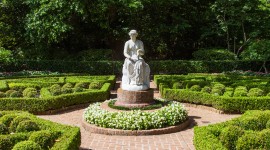Pioneer Information
Born in Berkeley, California, Emerson earned A.A and B.L.A degrees from the University of California, Berkeley, in 1957 and 1960 respectively. Upon graduating he worked as a draftsman and designer in the San Francisco office of Royston, Hanamoto, Mayes and Associates and later studied under Hideo Sasaki at Harvard’s Graduate School of Design, where he earned an M.L.A degree in 1962. From 1962 to 1965 Emerson served as a senior designer at Sasaki, Dawson, DeMay and Associates (now Sasaki), managing notable projects including Deere & Company World Headquarters in Moline, Illinois, and the Massachusetts Institute of Technology campus, collaborating with architects I. M. Pei and Eduardo Catalano. During this time, Emerson established his first office, Unicorn Studio, based in Baton Rouge, Louisiana. In 1965 Emerson was named a Fellow in Landscape Architecture at the American Academy in Rome, enabling him to travel for two years in Europe and the Middle East. His first years in practice and his time abroad profoundly influenced Emerson as a designer and teacher.
Returning to the United States in 1967, he joined the faculty of Louisiana State University’s School of Environmental Design (now College of Art & Design), where he taught in the Landscape Architecture program for 31 years. Emerson espoused Modernist principles that he learned from Sasaki and others, and he advocated for the experience of significant natural and designed landscapes, and exposure to myriad artforms, as fundamental to a designer’s development. Emerson’s own interests were diverse, including landscape design, opera, history, dance, theater, painting, stained glass, poetry, sculpture, photography, ecology, animals, and plants. Collectively, these interests informed his approach to teaching, inspired his firm’s design work, and resonated through his personal artwork.
Throughout his career, Emerson planned and rehabilitated cultural landscapes, including historic plantations, estates, institutional grounds, cemeteries, and gardens. In 1973 he began work on Magnolia Mound Plantation in Baton Rouge, for which he received an ASLA National Design Award in 1986. He remained involved in the landscape until his death.
In 1983 he created the firm, Emerson, Ribes and Associates, which became Emerson and Associates in 1988. Committed to the sympathetic revitalization and development of historic properties, his commissions included a landscape plan (1983) for Shadows-on-the-Teche in New Iberia, Louisiana, and preservation, management, and master plans (1985-2000) for Bayou Bend in Houston, Texas. Later projects include significant master plans, notably for the New Orleans Botanical Garden (1991-2000), the Atlanta History Center in Georgia (1998), Rienzi in Houston, Texas, (1999), and Oak Alley Plantation in Vacherie, Louisiana (2000). In many of these projects Emerson strived to interpret and make visible those histories and cultural lifeways embedded in the landscape, revealing them to a broader audience.
In 2000 Emerson was named a Fellow of the American Society of Landscape Architects (ASLA). He passed away on March 2, 2025, at the age of 89.












